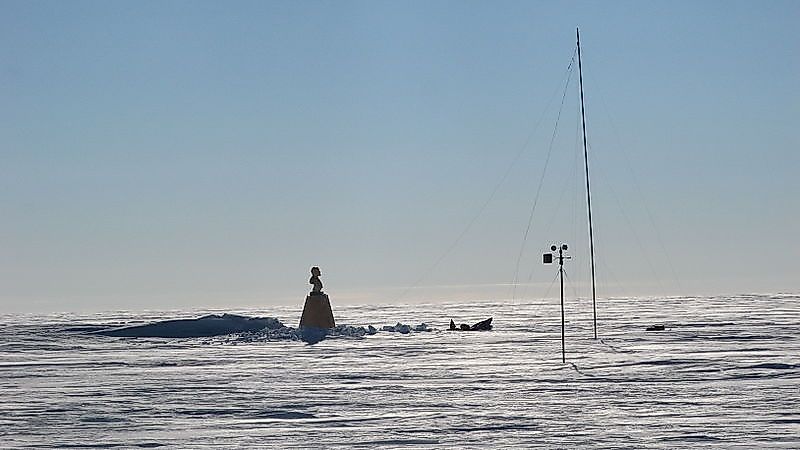The Poles Of Inaccessibility Of Our Planet

People have long known about the north and south poles located in Antarctica and the Arctic. These mark the farthest distance from the equator and are not the only poles in the world. Others are scattered about the planet, located on nearly every continent. These are the poles of inaccessibility, the most remote points in the world. Poles of inaccessibility are challenging to reach and are often defined as the furthest location from the coastlines of a continent. For anyone looking to get away from it all, the following points may be of interest.
Poles of Inaccessibility
Arctic Pole of Inaccessibility
Also known as the Northern Pole of Inaccessibility, this point is located on a shifting ice pack in the Arctic Ocean. It is the furthest point from land. Although the ice pack moves somewhat, its coordinates are recorded as 85°48′N 176°9′W, and the nearest land masses are Ellesmere Island, Komsomolets, and Genriyetta Islands. The climate is harsh with freezing temperatures and not one human settlement in proximity.
Southern Pole of Inaccessibility
This pole is located at a point on Antarctica that is farthest from the coast. However, many researchers debate the exact coordinates. The confusion comes from a disagreement over where exactly scientists should measure the coastline. It could be measured from the edge of the Antarctic landmass or from the edge of the ice shelves that surround it. Like its Arctic counterpart, there are no human settlements nearby.
Oceanic Pole of Inaccessibility
The Oceanic Pole is located in the middle of the Pacific Ocean between Chile and New Zealand. This point is farthest from any landmass on Earth with the nearest being 1,670 miles away, Ducie Island (part of the Cairn Islands). Geographers have nicknamed this pole Point Nemo referring the captain from Jules Verne’s Twenty Thousand Leagues Under the Sea.
Eurasian Pole of Inaccessibility
The European and Asian continents were combined to define the Eurasian Pole of Inaccessibility which most experts claim lies at 46°17′N 86°40′E, the farthest point from the ocean. Northwest China, near the Kazakhstan border, lays claim to this pole. In the middle of the Gurbantünggüt Desert, this pole is arid and filled with sand dunes. The nearest community is found to the south Ürümqi, with a population of nearly 3 million. Like other poles of inaccessibility, however, this location is often contested as not being the farthest from the coast because of the Gulf of Orb. This Russian Gulf connects the Orb River to the Arctic Ocean, and some researchers argue that it is part of the ocean and not a river as previously thought.
African Pole of Inaccessibility
This pole is located near the joining of three borders: the Central African Republic, Democratic Republic of Congo, and South Sudan. Coordinates for the African Pole are 5.65°N 26.17°E and the nearest town is Obo with a population of just over 12,000. The area is covered by savanna, and the climate is tropical with dry and rainy seasons.
Australian Pole of Inaccessibility
Australia’s Pole of Inaccessibility is 570 miles inland in the Northern Territory. This point is located along a dirt road that connects the small town of Papunya with Lake Lewis. The area, a semi-arid desert, is restricted Aboriginal land and requires an access permit. Once travelers obtain the access permit, the pole should be relatively easy to reach.
North American Pole of Inaccessibility
The North American Pole is located at 43.36°N 101.97°W and lies in the state of South Dakota in the US. This pole is only 7 miles north of Allen, a 420-person town with significant levels of poverty. The area is surrounded by hilly grassland and belongs to the Oglala Sioux Native American Tribe. The climate here ranges from hot, humid summers to freezing winters.
South American Pole of Inaccessibility
Brazil lays claim to the South American Pole of Inaccessibility which lies at 14.05°S 56.85°W. The area surrounding this point is filled with lush vegetation, canyons, and waterfalls. Three highways run around the pole but not through it making this location difficult to reach.
Attempts to Reach the Poles
Although these locations are meant to represent the most remote and difficult places to reach in the world, some of them are located near human settlements. Others, however, are truly off the beaten path. Their remoteness has not discouraged some explorers, however. Despite the rugged conditions of the Northern Pole of Inaccessibility, explorer Jim McNeill tried to reach the destination several times, failing each time. Nobody has yet reached this pole.
The Antarctic Pole has been reached, however, and interestingly enough, is home to a bust of Lenin. Russians built a research station here in 1958 and marked the location with Lenin, who faces toward Moscow in Russia. Once a functioning site, today, all that is left is one abandoned building and Lenin’s bust. The Oceanic Pole, or Point Nemo, has no commercial transportation routes running through it.Each of these locations, particularly those near communities, would make a great travel bucket list!
The Poles Of Inaccessibility Of Our Planet
| Rank | Pole of Inaccessibility | Location |
|---|---|---|
| 1 | Arctic Pole of Inaccessibility | 85°48′N 176°9′W |
| 2 | Southern Pole of Inaccessibility | Various locations have been proposed over the years. |
| 3 | Oceanic Pole of Inaccessibility | 48°52.6′S 123°23.6′W) |
| 4 | Eurasian Pole of Inaccessibility | 46°17′N 86°40′E |
| 5 | African Pole of Inaccessibility | 5.65°N 26.17°E |
| 6 | Australian Pole of Inaccessibility | 23°2′S 132°10′E/23.17°S 132.27°E |
| 7 | North American Pole of Inaccessibility | 43.36°N 101.97°W |
| 8 | South American Pole of Inaccessibility | 14.05°S 56.85°W |











